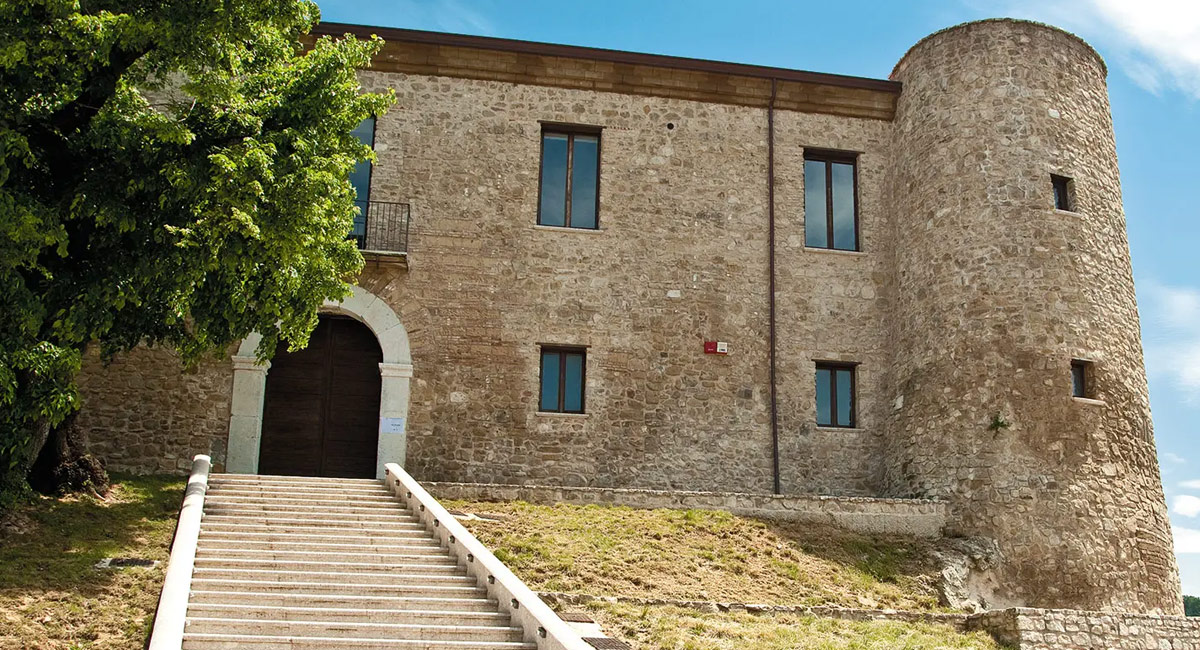ITINERARIES IN THE VALLEYS OF GOOD LIVINGManocalzati

Manocalzati, located in the middle Sabato Valley, originally consisted of three distinct residential areas: Casal Soprano and Casal Nuovo, corresponding to the current upper and lower areas of the municipality, and San Barbato, a separate village. The origin of the name is uncertain and may derive from Malecalbiati, a word indicating only partially cleared land. Artifacts dating back to the Iron Age and Roman times have been discovered in the area, including the reliefs used as spoil for the cladding of the bell tower of the Collegiate Church of San Marco Evangelista. The main religious buildings are located in the upper part of the village, including the Church of the Immaculate Conception, home to a 17th-century canvas dedicated to the Virgin, and the Chapel of Sant'Antonio, accessible via a path lined with plane trees. Palazzo Accomando preserves a beautiful late 18th-century portal. In the historic center of Manocalzati stands the Collegiate Church of San Marco Evangelista, a building restored several times, as evidenced by its classical style, but whose origins date back to the 12th century. The area is well-suited to the production of Fiano, although hazelnut cultivation is also widespread.
ITINERARIES IN THE VALLEYS OF GOOD LIVINGPlaces of Interest
Castle of San Barbato
Perched on the hill overlooking the small village that, along with three other settlements, makes up the municipality of Manocalzati and from which it takes its name, the Castle of San Barbato was built by the Lombards who settled here. The oldest document proving the castle's existence dates back to 1146: a parchment kept in the library of Montevergine. It recounts a meeting between the lord of the nearby Serra Castle, a certain Piero, and the lord of San Barbato, Malfrido, to settle a dispute regarding the ownership of some lands bordering the two territories. Today, the Castle of San Barbato clearly displays the features of a 15th-century Aragonese fortress, while retaining some typical features of the Lombard period. The structure consists of a simple, low, quadrangular building, with corner towers placed at the corners of the central body, which encloses the internal courtyard, with an open staircase leading into the courtyard. The castle, however, has a unique feature compared to other similar structures: the two towers on the southern side are circular and sloped, while the other two, located on the northern side, have a pointed plan. The entrance portal, located at the top of a high flight of steps, leads to the central courtyard, which overlooks all the ground-floor rooms covered by large barrel vaults.
Parish Church of St. Mark the Evangelist
The Church of San Marco Evangelista is the mother church of Manocalzati, located in the eponymous square that characterizes the historic center of the Irpinia town. The origins of the religious building are uncertain: according to some sources, it dates back to the 12th century; according to other sources, to around the mid-16th century. The church undoubtedly reflects the cult of San Marco Evangelista, well-known and widespread among the local community, thanks to the popular fair held in nearby Atripalda and the trade that the cities of the Amalfi Coast maintained with the inland areas of Campania via the Via Nucerina. The Church of San Marco Evangelista was restored several times thanks to the generosity of the faithful, as occurred, in particular, after the mission of the Fathers of St. Vincent de Paul in 1826. In 1986, the parish of San Barbato, a hamlet of Manocalzati with particular historical interest, was merged with the parish of San Marco. Today, the church stands out for its façade, featuring a beautiful stone portal, and its 17th-century bell tower. Within its walls, a stone block from ancient times depicting two half-length figures representing the Holy Apostles Peter and Paul can still be seen. Inside the religious building, several ancient 18th-century paintings depicting scenes from the lives of various saints are still preserved, further enhancing its preciousness. A majestic and solemn place, the Church of San Marco Evangelista is one of the symbols of Manocalzati's historic center.
Well and tunnel of Roman origin
The Roman tunnel of Manocalzati is located in the town of Faenzera. Its discovery was accidental: in 1964, local workers, while drilling a well for the new elementary school, uncovered a ventilation shaft and its underlying tunnel. At the invitation of the then Mayor, Benedetto Tirone, and Mario Del Mauro, the Speleological Group of the Naples Section of the Italian Alpine Club conducted a topographical survey of both the shaft and the entire tunnel. The shaft's mouth is located in front of the entrance to the former elementary school (now the ANAS Maintenance Center) at an altitude of approximately 352 meters above sea level, and its depth is approximately 40 meters. The well ends with a horizontal tunnel that branches off in two opposite directions, one towards the east in the Valle Chiusa area for a length of approximately 106 m and the other towards the west in the Sabato river incision for a length of approximately 133 m. The most interesting part of the tunnel is its cross-section: the clear height at the apex is approximately 180 cm, the width is approximately 65 cm at the highest point, and approximately 45 cm at the lowest. The roof is made of two tiles forming a 90° internal angle. Each tile, held in place with 16 cm long iron nails, measures 65 x 47 cm. The tiles are made of terracotta, a clay-like material, and all bear the following inscription impressed before firing: "ARRES-C- F POP PRI." This inscription represents the trademark of the factory that produced these construction elements. In the eastern tunnel, an interesting inscription, written on site and in Latin, was found on a roof tile. The discovery of this inscription is truly unusual, not only due to the limited space in the tunnel, but above all because of the subject matter of the inscription, which has been studied by the Superintendency. The hydraulic concept of this work is simple. At the lowest point of a closed valley, a well opens into a tunnel, which flows into the nearest open valley. This assumption is supported by the presence in the Valle Chiusa area of a Roman-era ruin, which may originally have been a specially constructed fortification. At the base of the ruin is a fracture tunnel whose dimensions are similar to those at the bottom of the well. Indeed, Monte Sant'Angelo and the Chiuppo promontory to its south enclose, on their right, a vast depression known as "la Chiusa"; on their left, however, and at a lower level than Valle Chiusa, the Sabato River flows. Therefore, the water collected in the closed valley, thanks to the construction of the tunnel, was channeled towards the Sabato River and the valley, freed from marshy waters, was reclaimed, reinstating grazing, which was the only economic resource for the local population.

